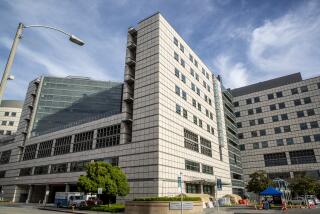Hospitals Strive to Update Care for Patients in Pain : Treatment: New technologies are tried by some institutions. Clinics to help sufferers are also being added.
- Share via
Traditionally, patients have anticipated hospitalization as a painful experience. But many hospitals in Orange County are striving to change that.
Not only are they adopting new technology for relief of surgical pain, but they are setting up clinics where people can go to soothe their chronic aches.
Within the past decade, more hospitals have begun to catch up with the latest pain management equipment and practices. Some have installed pump systems at bedsides that allow patients to control their pain medication after surgery, rather than wait for a nurse to give them injections.
Going further, some hospitals have begun to infuse narcotics near the spine through slender tubes known as catheters to reduce the severe pain following abdominal or chest surgery or total hip and joint replacements.
This pain relief has reduced respiratory complications in chest surgery patients by allowing them to breath more deeply and has promoted quicker recovery from hip and joint surgery by making it easier for patients to exercise, according to physicians who use the technique at UCI Medical Center in Orange and Hoag Hospital in Newport Beach.
Recognizing that not everyone in the medical community can keep up with the technological breakthroughs on the pain front, some hospitals, such as UCI, Hoag and Western Medical Center-Santa Ana, have developed teams of anesthesiologists, nurses and pharmacists available around the clock to assist private physicians who need help with more difficult pain cases.
Administrators at Mission Hospital Regional Medical Center in Mission Viejo and Fountain Valley Regional Hospital and Medical Center said they, too, are considering a hospital-based pain service like that at UCI and Hoag.
“We would have the opportunity to change behavior on the part of staff physicians,” said Fountain Valley Regional Hospital administrator Richard Butler.
Before adopting new procedures, some hospitals are surveying the attitudes of their staff doctors, nurses and patients toward the status of pain control in their institutions and prevailing attitudes toward the use of narcotics.
St. Joseph Hospital in Orange, Fountain Valley Regional Hospital and St. Jude Medical Center in Fullerton have recently completed such surveys.
Taking their cue from pain experts, hospitals are increasingly urging their staff doctors and nurses to honor patients as the ultimate authorities in assessing their own pain. They are requiring nurses to determine the level of each patient’s pain when they make their regular rounds. In some hospitals, the ebb and flow of pain is tracked on a separate chart.
Nurses ask adult patients to pick a number between zero and 10 to describe the severity of their pain, while children are asked to choose faces ranging from a grin to a tearful grimace.
Children too young to express their pain verbally concern nurses such as Margaret Bard at Children’s Hospital of Orange County. Bard has formed a task force to look at pain control among infants at CHOC.
The conclusion: “We really didn’t feel what we were doing was optimal. We can tell by their crying, irritability and sleeplessness and by higher blood pressure and heart rates,” she said.
In response, Bard said, the CHOC staff, with the cooperation of some doctors, has begun using intravenous morphine infusions for infants recovering from surgery, a technique previously confined to the intensive care unit.
Also, CHOC spokeswoman Marilyn Fisher said over the last five years the hospital has been using newer drugs, such as Versed and Sentanyl, that greatly relieve the pain of young cancer victims undergoing such procedures as spinal taps and bone marrow removal.
CHOC is also taking part in research to evaluate a new anesthetic cream that numbs the skin and helps reduce the pain of needles.
And hospitals are beginning to market themselves to the public as places to go for treatment of chronic pain from such ailments as migraine headaches and aching backs.
To help chronic pain sufferers, Mission Hospital Regional Medical Center is developing a chronic pain treatment center on its grounds that will draw upon a panel of neurosurgeons, neurologists, orthopedists and oncologists.
UCI Medical Center and St. Jude Medical Center also have comprehensive chronic pain services and Buena Park Doctors Hospital recently opened a center to diagnose and treat head and neck pain. Other chronic pain centers have sprouted up near Hoag Hospital, Western Medical Center-Santa Ana and Fountain Valley Regional Hospital and Medical Center.
“Any hospital that wants to be a full-service hospital will have to offer a comprehensive pain management system,” said Dr. Steven Hufstedler, an anesthesiologist at Martin Luther Hospital in Anaheim, where he intends to establish a chronic pain clinic within 12 to 18 months.
More to Read
Sign up for Essential California
The most important California stories and recommendations in your inbox every morning.
You may occasionally receive promotional content from the Los Angeles Times.










